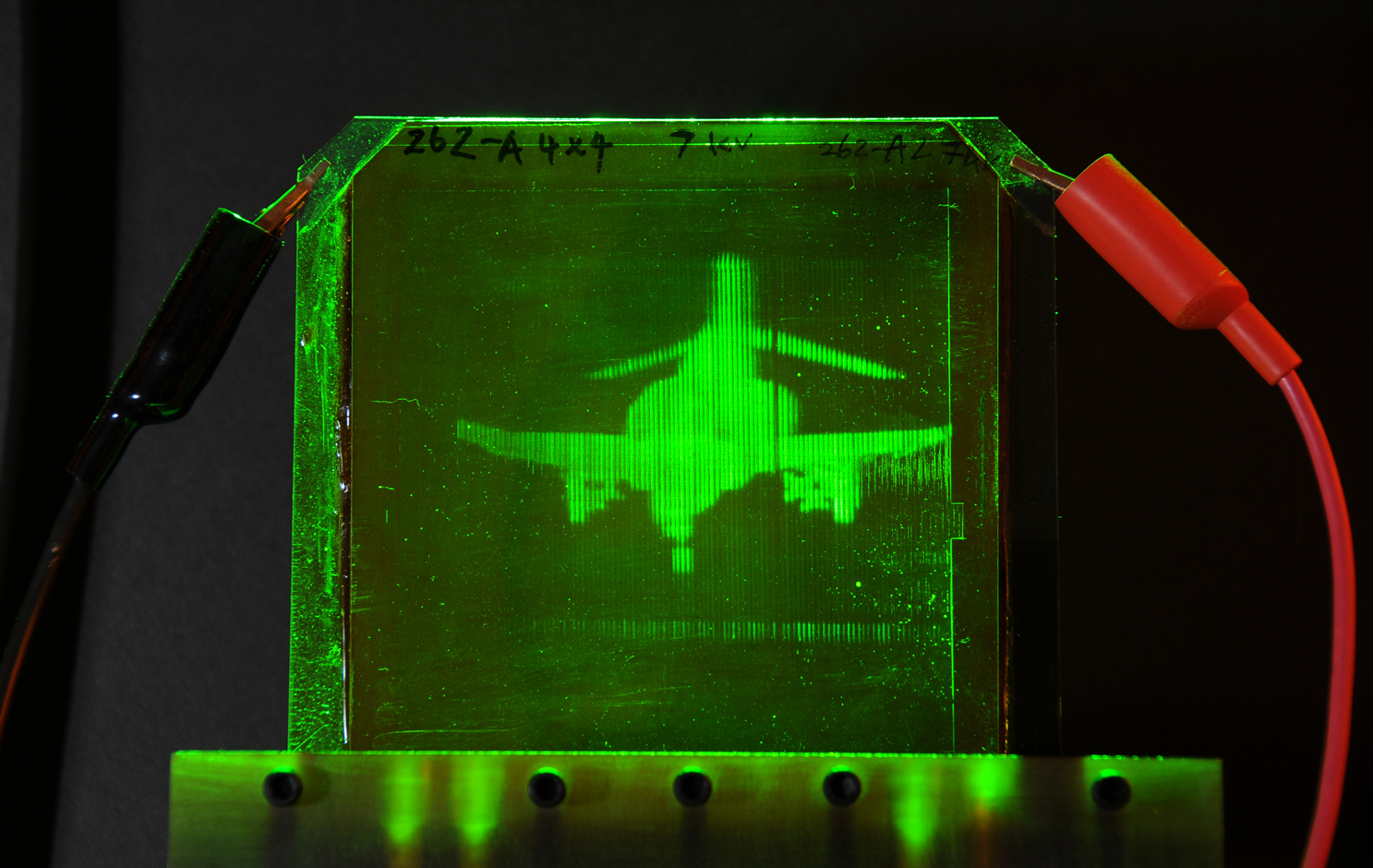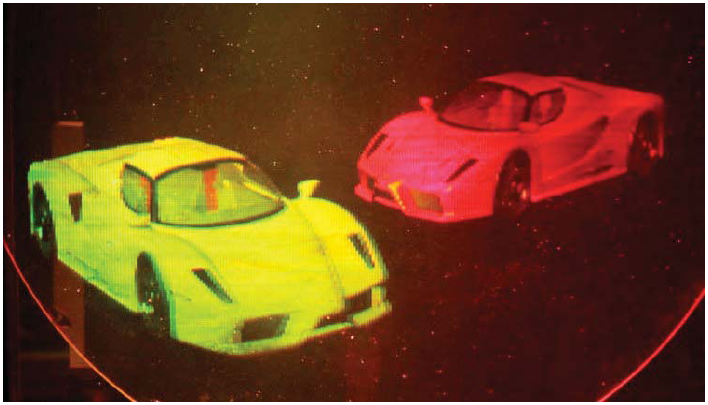
A refreshable holographic image of an F-4 fighter jet. Credit: gargaszphotos.com/College of Optical Sciences, The University of Arizona
Holograms may seem like an original invention from some science fiction films. A famous scene often mentioned in this context is that from Star Wars where Princess Leia records an important holographic message, ending with the words “Help me, Obi-Wan Kenobi“.
Such visions of holograms aren’t fiction. In a paper published in Nature, Nasser Peyghambarian, Pierre-Alexandre Blanche and colleagues from the College of Optical Sciences at The University of Arizona demonstrate a holographic system that is capable of displaying holograms at speeds approaching almost that of video capability. (and sure enough, they do mention Star Wars in the abstract of the paper…)
Holograms have been invented in 1947 by Dennis Gabor. They are made by shining a laser beam on an object and then recording the laser light reflected by the object on a photographic film. Simultaneously, a reference beam of the same laser is directly guided to the photographic film, where it causes an interference of the two beams. The interference pattern stored in the photographic film not only contains information on the light intensity (as in conventional photos) but also the phase difference between the two laser beams. The phase difference is a measure of the three-dimensional shape of the object. Together, intensity and phase contain the complete information of a light beam.
To recover the holographic image, the original laser needs to be used. Therefore, more practical ways of writing holograms have been develop and that do not require the original laser for viewing. Regular white light can be used instead. Although image quality for these holograms is not as good, they are widely used, for example on credit cards. Holograms can also be artificially created, without the use of an actual object, but by using a computer to calculate the necessary holographic interference pattern. Or information from a camera is digitally scanned and used to create a hologram elsewhere. “Holographic telepresence means we can record a three-dimensional image in one location and show it in another location, in real-time, anywhere in the world,” says Peyghambarian.
Although static holograms are widely available, true holographic video systems that are able to refresh holograms at video rates haven’t been demonstrated yet. Of course, there are 3D television sets on the market. However, these use different techniques, usually stereoscopic projections, which have the disadvantage that either special glasses have to be worn, or they only work really well if you sit straight in front of the TV.

Even multiple colours are possible. Reprinted by permission from Macmillan Publishers Ltd. Nature, doi: 10.1038/nature09521 (2010).
For animated holograms, the holographic film needs to be rewritten constantly. This can be done with polymers. The problem is that there is always a trade-off between parameters such as write time and the time required to erase an image before writing the next one. Previously it took three minutes to rewrite a holographic image, which is obviously too slow.
The researchers from the University of Arizona now developed their technique further and use a different polymer mixture that is more responsive. It only takes a single shot from an intense nanosecond laser pulse to write a holographic pixel. Unfortunately, the laser only operates 50 Hz, which is too slow for animated holograms — a single hologram of suitable size still takes about two seconds to write, which is still too slow for typical video rates of 30 frames per second.
The problem is that the laser pulses needed to write the polymer film are too energetic to increase writing speeds, says Blanche. “The problem is the energy requirement. The material needs around 100 mJ/cm² of energy per hogel (elementary holographic pixel). At 50 Hz, this gives a 5 Watt laser, doable. Now to go video rate, we need to go 60 times faster. A laser with a repetition rate of 3 kHz and 100 mJ/pulse is 300 Watts! Quite a beast if you allow me the expression.”
To compare, a typical laser pointer has around 1 mW of power, so a 300 W laser is as powerful as up to 300,000 laser pointers. Even 5 W lasers are powerful enough that they have to be operated with extra care. Clearly, real animated motion isn’t feasible yet. As a first step the energy required to write the hologram needs to come down. “We are now focusing our research on the sensitivity of the material. If we can improve the later by let’s say a factor of 60, we can do video rate holography with the same 5 Watt laser,” argues Blanche. And these aren’t the only issues. During operation the polymer film has to be subjected to 7,000 Volts, which probably will degrade the film over time.
Either way, given the advance made so far, with writing times coming down from three minutes to two seconds within only two years, it seems possible that we might eventually realize holographic videos. Then, holographic messages will be less likely to be the royal “help me, Obi-Wan Kenobi”, but could be something more mundane such as “dude, let’s meet for drinks”…
Reference:
Blanche, P., Bablumian, A., Voorakaranam, R., Christenson, C., Lin, W., Gu, T., Flores, D., Wang, P., Hsieh, W., Kathaperumal, M., Rachwal, B., Siddiqui, O., Thomas, J., Norwood, R., Yamamoto, M., & Peyghambarian, N. (2010). Holographic three-dimensional telepresence using large-area photorefractive polymer Nature, 468 (7320), 80-83 DOI: 10.1038/nature09521


November 4, 2010 at 04:54
Odd that the authors did not mention this, done almost 15 years ago…
http://www.media.mit.edu/spi/holoVideoAll.htm
November 4, 2010 at 10:20
Yes, that’s right. These projections, however use quite drastic compression methods, which not only reduces image quality but also places limits on the size of the hologram that can be displayed (these look like about an inch in size). In this Nature paper they use 12 inch displays at what seems much better quality, too). Also, the display seems based on a stereographic projection rather than writing an actual hologram in a polymer (as in this case). The latter is far more difficult, but produces better quality. Having said that, I am certainly not an expert… 🙂
November 10, 2010 at 05:41
Thanks for a good article.
Given more research, refresh rate and power requirements may come down – even at Moore’s law rate – who knows?
I have a few questions about this holographic video.
1. Shooting such a video! It requires a laser to shoot. How convenient is it going to be to shoot in the day light? Think of shooting a video of wildlife, children or VIPs.
2. The depth perception depends on the phase difference. Would it not “roll over” objects at various distances into the same depth? [Think of shooting Grand Canyons. Two points at various depths may reflect the laser at the phase ( + 2 * pi * n ) for different values of n but the the perception will be at the same depth. Do I even understand the principle clearly?
November 10, 2010 at 09:12
1. to shoot a video you need regular cameras. It is true that for classical holograms where you directly write a hologram into a photographic film you need a laser. But in this technique you take images from different directions. The computer then *simulates* what the laser would do. So no danger during recording.
2. no, this is not a problem. Amplitude/intensity and phase are the only two pieces of information required. However, for depth perception in terms of hologram image quality something else is important, the so called coherence length. This tells you how long the individual light particles in a laser beam are in sync. If the length during which they are in sync is shorter than the image depth it won’t work, as you could not determine the difference in phase – the laser reflection from the back end of the object would not be in sync anymore with that reflected from the front. In practical lasers this is always a limit. But for an hypothetical, ideal laser it wouldn’t be an issue. (note, if you do the same with cameras and computer simulations, again this practical issue won’t be a problem)